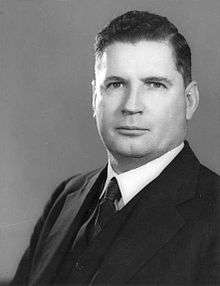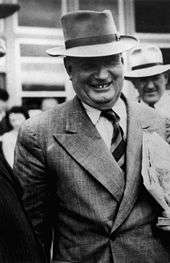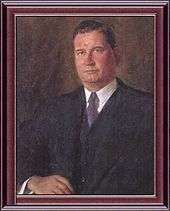Arthur Fadden
| The Right Honourable Sir Arthur Fadden GCMG | |
|---|---|
 | |
| 13th Prime Minister of Australia Elections: 1943 | |
|
In office 29 August 1941 – 7 October 1941 | |
| Monarch | George VI |
| Governor-General | Lord Gowrie |
| Deputy | Billy Hughes |
| Preceded by | Robert Menzies |
| Succeeded by | John Curtin |
| Treasurer of Australia | |
|
In office 19 December 1949 – 9 December 1958 | |
| Prime Minister | Robert Menzies |
| Preceded by | Ben Chifley |
| Succeeded by | Harold Holt |
|
In office 28 October 1940 – 6 October 1941 | |
| Prime Minister |
Robert Menzies Arthur Fadden |
| Preceded by | Percy Spender |
| Succeeded by | Ben Chifley |
| Minister for Civil Aviation Minister for Air | |
|
In office 14 August 1940 – 28 October 1940 | |
| Prime Minister | Robert Menzies |
| Preceded by | James Fairbairn |
| Succeeded by | John McEwen |
| Leader of the Country Party | |
|
In office 12 March 1941 – 26 March 1958 | |
| Deputy | John McEwen |
| Preceded by | Archie Cameron |
| Succeeded by | John McEwen |
| Deputy Leader of the Country Party | |
|
In office 16 October 1940 – 12 March 1941 | |
| Leader | Vacant |
| Preceded by | Harold Thorby |
| Succeeded by | John McEwen |
| Leader of the Opposition | |
|
In office 7 October 1941 – 23 September 1943 | |
| Prime Minister | John Curtin |
| Deputy | Billy Hughes |
| Preceded by | John Curtin |
| Succeeded by | Robert Menzies |
| Member of the Australian Parliament for Darling Downs | |
|
In office 6 November 1936 – 10 December 1949 | |
| Preceded by | Littleton Groom |
| Succeeded by | Reginald Swartz |
| Member of the Australian Parliament for McPherson | |
|
In office 10 December 1949 – 22 November 1958 | |
| Preceded by | New seat |
| Succeeded by | Charles Barnes |
| Member of the Queensland Legislative Assembly for Kennedy | |
|
In office 11 June 1932 – 11 May 1935 | |
| Preceded by | Harry Bruce |
| Succeeded by | Cecil Jesson |
| Personal details | |
| Born |
13 April 1894 Ingham, Queensland, Australia |
| Died |
21 April 1973 (aged 79) Brisbane, Queensland, Australia |
| Political party | Country Party |
| Other political affiliations | Country and Progressive National Party |
| Spouse(s) | Ilma Nita Thornber |
| Children | 4 |
| Religion | Presbyterian |
Sir Arthur William Fadden, GCMG (13 April 1894 – 21 April 1973) was an Australian politician and the 13th Prime Minister of Australia.
Early life
Fadden was born in Ingham, Queensland, on 13 April 1894, the son of a Presbyterian police officer. He was educated at state schools, and later studied accountancy while working as a clerk. Once he had qualified he became assistant Town Clerk of Mackay, then Town Clerk. In 1919 Fadden helped form the North Queensland Rugby League, and served as its founding secretary.[1] In the 1920s he established a successful accountancy firm with offices in Brisbane and Townsville. He was active in the Country Party from its foundation.
Career
In 1932 Fadden was elected for one term to the Legislative Assembly of Queensland as member for Kennedy.[2] He was defeated in 1935. The following year, though, he won a by-election in the federal seat of Darling Downs. He was a blunt, effective debater and soon made an impression. When Archie Cameron resigned suddenly as Country Party leader in 1940, there was a deadlock between Earle Page and John McEwen in the ballot to select a new leader, and Fadden was chosen as a compromise candidate. He was appointed Minister for Supply and Development, then Minister for Air, then Treasurer (finance minister).

Prime Minister of Australia

In August 1941 Robert Menzies resigned as Prime Minister and leader of the senior party in the coalition, the United Australia Party (UAP).[3] Although the non-Labor Coalition had been in power for a decade, the UAP was so bereft of leadership that it was forced to elect former Prime Minister Billy Hughes as its new leader. Under normal circumstances, this would have made Hughes Prime Minister for a second time. However, Hughes was a month shy of 78, and was viewed as too old and frail to be anything other than a stopgap leader, especially during wartime. Under the circumstances, on 28 August a joint UAP-Country meeting chose Fadden as Coalition leader even though the Country Party was the smaller of the two non-Labor parties. Fadden was duly sworn in as Prime Minister the next day, and also remained Treasurer. He was the only member of the Country/National Party to serve as Prime Minister without an expectation of a short tenure (the other two Country/National Prime Ministers, Page and McEwen, served as caretakers).
Nevertheless, Fadden's term of office was troubled from the start. Even parliamentarians in his own party feared the worst. It was later reported that Fadden decided against moving into The Lodge, the official Prime Minister's residence in Canberra, after fellow Country Party member Archie Cameron crudely told him that he would "scarcely have enough time to wear a track from the backdoor to the shithouse before you’ll be out".[4]
On 3 October, the two independent legislators who had been keeping the Coalition in office for the last year, Arthur Coles and Alexander Wilson, voted against Fadden's budget. Coles and Wilson had been so disgusted with how Menzies had been treated that they refused to support the Coalition any longer. Due to this loss of supply, Fadden submitted his government's resignation to the Governor-General Lord Gowrie later the same day. This was the last occasion to date on which an Australian government was forced to resign after being defeated on the floor of the House of Representatives.[5] Fadden joked that he was like the Flood: he had "reigned for 40 days and 40 nights".
The Governor-General then summoned Coles and Wilson and obtained their assurances that, if he commissioned ALP leader John Curtin as Prime Minister, they would support him and end the instability in government. Coles and Wilson agreed to this, and Curtin was sworn in on 7 October.
Leader of the Opposition
Following the fall of his ministry, a joint UAP-Country Party meeting endorsed Fadden as Leader of the Opposition, even though the UAP was nominally the senior coalition partner. The Coalition sank into near-paralysis in opposition. Even allowing for Curtin's personal popularity, and for the significant advantages which an incumbent government in a Westminster system has in wartime, Fadden as opposition leader proved a disappointment; he was unable to get the better of Curtin. The Coalition suffered a crushing loss in the 1943 election. It was reduced to 19 seats, of which Fadden's party held a mere seven. Accepting responsibility for this severe defeat, Fadden then handed the Opposition leadership back to Menzies, who had resumed the UAP leadership.
After the Coalition was again vanquished at the 1946 election, Fadden resumed his political partnership with Menzies. Two years earlier, Menzies had folded the UAP into the new Liberal Party of Australia. There was some speculation that the Country Party would be included in the merger (as had already happened in several states), but Fadden was keen to assert the independence of his party.
Always an outspoken conservative, in the late 1940s he became a strong anti-communist, urging Menzies to ban the Communist Party if he ever came to power. Indeed, in the lead up to the 1949 federal election, Fadden often made inflammatory claims about the "socialist" nature of the Labor Party which Menzies could then "clarify" or repudiate as he saw fit, thus appearing more "moderate". His often extreme views were concealed behind a jolly public manner and he enjoyed his nickname "Artie."
Fadden was a friend of Robert Frederick Bird Wake, one of the country's leading security experts at the time. It was an odd relationship, based on their mutual love of Queensland and Queenslanders. Wake, who was a founder director with the Australian Security Intelligence Organisation (1949), was supplied with inside information by Fadden about security leaks in the UK. Although Wake was more inclined to support the Labor Party, the relationship stood the test of time and proved mutually beneficial.[6]
The Coalition won a massive victory in the 1949 election, and Fadden, who transferred to the newly created seat of McPherson on the Gold Coast, became Treasurer in the second Menzies government. Although inflation was high in the early 1950s, forcing him to impose several "horror budgets," he generally presided over a booming economy, with times especially good for farmers.
Fadden retired at the 1958 election. Thereafter he faded from the news, remaining quietly in Brisbane until his death in 1973. He was accorded a state funeral which proceeded from the Toowong Presbyterian Church to the Mt Thompson Crematorium.[7][8]
Honours

Fadden was made a Knight Commander of the Order of St Michael and St George (KCMG) in 1951.[9] The honour was conferred upon Fadden by King George VI in London on 31 January 1952, only a week before the King's death.[10] In 1958 Fadden raised to Knight Grand Cross (GCMG) of the order.[11] The Canberra suburb of Fadden and the Division of Fadden are named after him.
In 1975 he was honoured on a postage stamp bearing his portrait issued by Australia Post.[12][13]
Fadden Ministry
29 August 1941 to 7 October 1941
- Rt Hon Arthur Fadden, MP: Prime Minister, Treasurer (CP)
- Rt Hon William Morris Hughes, MP: Attorney-General, Minister for the Navy (UAP)
- Rt Hon Robert Menzies, KC MP: Minister for Defence Co-ordination (UAP)
- Hon Percy Spender, KC MP: Minister for the Army (UAP)
- Senator Hon George McLeay: Vice-President of the Executive Council, Minister for Supply and Development (UAP)
- Hon John McEwen, MP: Minister for Air, Minister for Civil Aviation (CP)
- Senator Hon Hattil Foll: Minister for the Interior, Minister for Information (UAP)
- Rt Hon Sir Earle Page, GCMG MP: Minister for Commerce (CP)
- Hon Sir Frederick Stewart, MP: Minister for External Affairs, Minister for Health, Minister for Social Services (UAP)
- Senator Hon Philip McBride: Minister for Munitions (UAP)
- Hon Eric Harrison, MP: Minister for Trade and Customs (UAP)
- Hon Harold Holt, MP: Minister for Labour and National Service (UAP)
- Senator Hon Herbert Collett: Minister for Repatriation (UAP)
- Hon Thomas Collins, MP: Postmaster-General (CP)
- Senator Hon John Leckie: Minister for Aircraft Production (UAP)
- Hon Larry Anthony, MP: Minister for Transport (CP)
- Hon Eric Spooner, MP: Minister for War Organisation of Industry (UAP)
- Hon Joe Abbott, MP: Minister for Home Security (CP)
- Hon Allan MacDonald, MP: Minister for External Territories (UAP)
References
- ↑ Sean Fagan. "Australia's "Rugby League" Prime Ministers". RL1908. Retrieved 30 March 2011.
- ↑ "Alphabetical Register Of Members Of The Legislative Assembly 1860 – 2012" (PDF). Parliament of Queensland. Archived from the original (PDF) on 31 October 2013. Retrieved 22 November 2012.
- ↑ http://primeministers.naa.gov.au/primeministers/menzies/in-office.aspx
- ↑ Arklay, p. 80.
- ↑ Gavin Souter, Acts of Parliament, p. 341
- ↑ Valdemar Robert Wake, No Ribbons or Medals: the story of 'Hereward' an Australian counter espionage officer
- ↑ "Family Notices". The Canberra Times. 47, (13,418). Australian Capital Territory, Australia. 25 April 1973. p. 13. Retrieved 8 May 2016 – via National Library of Australia.
- ↑ Arthur William Fadden (1895 - 1973) — Heaven Address. Retrieved 8 May 2016.
- ↑ It's an Honour - Fadden KCMG
- ↑ "Sir Arthur Fadden Invested By King". Nla.gov.au. 1 February 1952. Retrieved 30 March 2011.
- ↑ It's an Honour - Fadden GCMG
- ↑ "Arthur Fadden". Australian Coin and Stamp Company. Retrieved 22 November 2012.
- ↑ "Australian Stamps - Year 1975". Australia Postage Stamps. Retrieved 22 November 2012.
Further reading
- Arklay, T. (2014) Political Silhouette, Australian Scholarly: Melbourne. ISBN 978 1 925003 84 0.
- Fadden, Arthur (1969), They Called Me Artie, Jacaranda Press
- Hughes, Colin A (1976), Mr Prime Minister. Australian Prime Ministers 1901-1972, Oxford University Press, Melbourne, Victoria, Ch.14. ISBN 0-19-550471-2
External links
| Wikimedia Commons has media related to Arthur Fadden. |
- "Arthur Fadden". Australia's Prime Ministers. National Archives of Australia. Archived from the original on 26 July 2010. Retrieved 29 June 2010.
- Cribb, Margaret Bridson (1988). "Fadden, Sir Arthur William (1894 - 1973)". Australian Dictionary of Biography. Canberra: Australian National University. Retrieved 29 June 2010.
- "Prime Ministers of Australia: Arthur Fadden". National Museum of Australia. Retrieved 29 June 2010.
| Political offices | ||
|---|---|---|
| Preceded by James Fairbairn |
Minister for the Air Minister for Civil Aviation 1940 |
Succeeded by John McEwen |
| Preceded by Robert Menzies |
Treasurer of Australia 1940 – 1941 |
Succeeded by Ben Chifley |
| Prime Minister of Australia 1941 |
Succeeded by John Curtin | |
| Preceded by John Curtin |
Leader of the Opposition 1941 – 1943 |
Succeeded by Robert Menzies |
| Preceded by Ben Chifley |
Treasurer of Australia 1949 – 1958 |
Succeeded by Harold Holt |
| Parliament of Australia | ||
| Preceded by Littleton Groom |
Member for Darling Downs 1936–1949 |
Succeeded by Reginald Swartz |
| New division | Member for McPherson 1949–1958 |
Succeeded by Charles Barnes |
| Parliament of Queensland | ||
| Preceded by Harry Bruce |
Member for Kennedy 1932 - 1935 |
Succeeded by Cecil Jesson |
| Party political offices | ||
| Preceded by Archie Cameron |
Leader of the Country Party 1940 – 1958 |
Succeeded by John McEwen |
| Preceded by Harold Thorby |
Deputy Leader of the Country Party 1940 |
Succeeded by John McEwen |